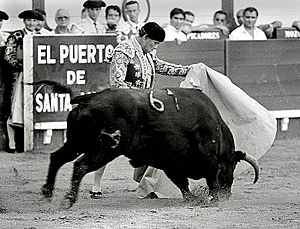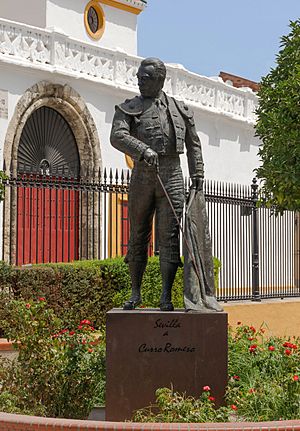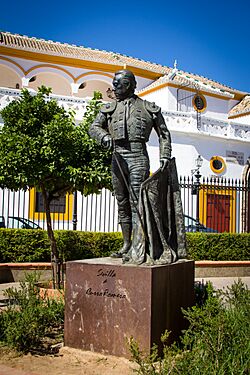Curro Romero facts for kids

Romero fighting a Núñez del Cuvillo bull at the El Puerto de Santa María bullring.
|
|
| Personal information | |
|---|---|
| Birth name | Francisco Romero López |
| Nickname(s) | El Faraón de Camas |
| Nationality | Spanish |
| Born | 1 December 1933 Camas, Seville, Spain |
| Monuments | Statue at la Maestranza, Seville |
| Occupation | Bullfighter |
| Years active | 1954–1999 |
| Agent | José Brageli Antonio Chaves Manuel Cisneros Lacruz José Ignacio Sánchez Mejías apoderados |
| Spouse(s) | Concha Márquez Piquer Carmen Tello Barbadillo |
| Website | http://www.curro-romero.com/ |
Francisco Romero López (born 1 December 1933), known as Curro Romero, is a famous Spanish bullfighter. People also call him El Faraón de Camas, which means "The Pharaoh of Camas". He started his professional career in his hometown of Camas on 22 August 1954.
Contents
Early Life and Dreams
Curro Romero was born on 1 December 1933 in Camas, a town in Andalusia, Spain. His family was very humble. He lived with his uncle in a small, cold house.
Family and Hobbies
His father worked at the fish market and loved both flamenco music and bullfighting. Curro's mother, Andrea, worked at an olive warehouse. Even though they didn't have much, Curro and his sisters, María and Buendía, always had food. Curro remembers his mother's tasty stews and fish dishes.
Curro learned about bullfighting from his father. His father enjoyed watching bullfights but never dared to step into the arena himself. Curro, however, chose to become a bullfighter. He also learned about flamenco from his father.
Leaving School and Finding His Path
Curro left school when he was only 12 years old. He felt he wasn't learning much there. He needed to work to help his family. He became a shepherd, looking after cows, sheep, and pigs on a farm near the Guadalquivir River. He earned a small amount of money and some food each day. He didn't like being told what to do, so he quit this job soon after.
While working on the farm, Curro could hear the cheers from the bullring in Seville, which was less than 3 kilometers away. This sound made him dream of bullfighting. He would practice at home, pretending to fight bulls with any cloth he could find. Curro believes that his time on the farm helped him decide to become a bullfighter.
His grandmother, María, helped him get a job as an errand boy for a pharmacist in Seville. This job came with a bicycle. The pharmacist knew about Curro's dream and let him use the bike to go watch bullfights. Curro also visited inns where bullfighters gathered, sharing his passion for his favorite football team, Betis.
Becoming a Bullfighter
Curro Romero's first time facing a bull was when he was 13 years old. It was a young female bull (heifer) from a bull farm.
First Steps in the Arena
His first professional fight without horses (called picadores) happened on 22 August 1954. This was in his hometown of Camas. He then fought bulls with horses for the first time in Utrera on 8 September 1954.
Curro made his debut at the famous Las Ventas bullring in Madrid on 18 July 1957. Later that year, he also appeared as a novillero (a beginner bullfighter who fights young bulls) at the Maestranza in Seville. Fans loved his performance so much that they wanted him to walk around the arena to receive their cheers. He was even carried out on people's shoulders through the Prince's Gate after cutting two ears from the bulls.
Becoming a Full Bullfighter
On 18 March 1959, Curro Romero officially became a full bullfighter (this is called taking his alternativa). This happened at the Valencia bullring. His "godfather" for this important event was Gregorio Sánchez. He performed well, but it wasn't a complete success.
Just two months later, on 19 May 1959, his alternativa was confirmed at Las Ventas in Madrid. This time, Pepe Luis Vázquez Garcés was his "godfather." The event was cut short due to rain.
Curro Romero also fought in bullrings in other countries. On 23 January 1960, he made his debut in Manizales, Colombia. On 24 February 1963, his alternativa was confirmed at the Plaza de Toros México in Mexico City.
Great Successes
Romero was carried out on shoulders through the Prince's Gate at the Maestranza in Seville five times. This is a huge honor for a bullfighter. On one occasion, he even refused the honor. One of his most amazing performances in Seville was on 19 May 1966. He fought six bulls by himself and cut eight ears, which is a record for the Maestranza.
He was even more successful at Las Ventas in Madrid, where he was carried out through the Great Gate seven times. On 24 May 1973, he cut two ears but chose not to be carried out on shoulders.
In 1967, Curro Romero performed one of his best faenas (a series of passes with the cape before the bull is slain) at the Maestranza. The crowd was so impressed that they carried him out on their shoulders, even though he didn't cut any ears.
Injuries in the Ring
Bullfighting is a dangerous profession, and Curro Romero was injured many times. He was badly gored (pierced by a bull's horn) on nine occasions throughout his career.
Romero's Unique Style
Curro Romero's bullfighting style was very special and inspiring to many. A famous bullfighting critic, Antonio Díaz Cañabate, said that watching Romero was like seeing "the dawn of pure bullfighting." He believed that a magical "elf" seemed to guide Romero's cape and movements. Whether he had amazing or difficult afternoons, his fans always supported him completely.
Retirement and Legacy
Curro Romero fought about 900 bullfights in his career. He officially said goodbye to bullfighting at a festival in La Algaba, Seville, on 22 October 2000. He cut three ears at this event. However, the very last time he wore his special bullfighting suit (called the Traje de luces) was on 10 September 2000, in Murcia.
His career was one of the longest ever, lasting 42 years. He was known for having both incredible successes and big failures. Fans were often divided into two groups: curristas, who loved him no matter what, and anticurristas, who were not his fans. He retired at 66 years old. Curro Romero is a big fan of the football team Real Betis Balompié.
In 2001, a group of reporters and bullfighting fans named Curro Romero as one of the ten most important bullfighters of the 20th century.
Personal Life
On 26 October 1962, Curro Romero married singer Concha Márquez Piquer. They had two daughters, Concha and Coral. Sadly, Coral died in an accident in 1986. He later divorced his first wife in 1982. On 16 February 2003, he married Carmen Tello Barbadillo in a civil ceremony. After his first wife passed away in 2021, he and Carmen Tello also had a church wedding on 18 December 2022.
Health Updates
After retiring, Curro Romero has faced some health challenges. In 2020, he had a laryngeal tumor. Instead of surgery, which could have made him lose his voice, he had radiotherapy treatments. The tumor has since disappeared.
In May 2024, at 90 years old, he had a household accident and broke his hip. He had surgery and is now recovering at home with his wife's help.
Awards and Honors
Curro Romero has received many important awards and honors, which allow him to be called Excelentísimo Señor (The Most Excellent Sir). Some of these include:
- 1993: The Medal of Andalusia, for his exceptional contributions.
- 2005: Named a Favorite Son of the Province of Seville.
- 1997: The Gold Medal of Merit in the Fine Arts.
- 2008: Became an Academic at the Real Academia de Bellas Artes de Santa Isabel de Hungría in Seville. He was the first bullfighter to receive this honor.
- 2020: Named a Favorite Son of Andalusia.
See also
 In Spanish: Curro Romero para niños
In Spanish: Curro Romero para niños



